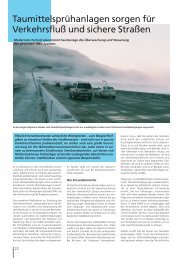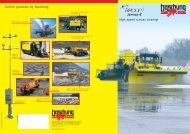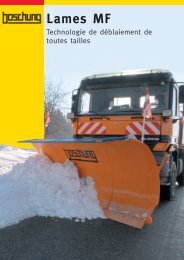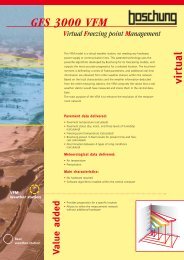Physical bases of freezing point measurement using ... - Boschung
Physical bases of freezing point measurement using ... - Boschung
Physical bases of freezing point measurement using ... - Boschung
Create successful ePaper yourself
Turn your PDF publications into a flip-book with our unique Google optimized e-Paper software.
Proceedings <strong>of</strong> the 9 th SIRWEC Conference 15-17 March 1998, Luleå, Sweden 275<br />
therefore retarding further <strong>freezing</strong>. The accumulation <strong>of</strong> heat now being the limiting factor,<br />
ice continues to grow slowly at a constant rate. The temperature stays at Tm as far as the heat<br />
generation is greater or equal than the heat withdrawal. When the rate <strong>of</strong> cooling becomes<br />
greater than the rate <strong>of</strong> latent heat liberation, the temperature once again begins to fall. When<br />
all the water has frozen, the rate <strong>of</strong> cooling depends on the thermal conductivity <strong>of</strong> the<br />
solidified system. The temperature is then lowered until the asymptotic temperature Ta is<br />
reached.<br />
In the case <strong>of</strong> the cooling <strong>of</strong> pure water, the behavior is comparable to the one <strong>of</strong> an<br />
aqueous saline solution, with the differences that Tm will be precisely 0 °C and the <strong>freezing</strong><br />
will not be retarded by the phenomenon described above.<br />
The active probe achieves such a cooling and measures Tm by means <strong>of</strong> a thermocouple<br />
or a platinum RTD 1 . The cooling is stopped as soon as Tbc is reached. Note that in the rest <strong>of</strong><br />
the text, for reasons <strong>of</strong> more common usage in our field, Ts (temperature <strong>of</strong> solidification, or<br />
<strong>freezing</strong> <strong>point</strong> temperature 2 ) will be used instead <strong>of</strong> Tm.<br />
The shape <strong>of</strong> the cooling curve is the same whatever the deicing product my be, salt or<br />
deicers specially used on the airports such as ethylene glycol.<br />
supercooling<br />
T<br />
Tm<br />
T0<br />
T bc<br />
T a<br />
0<br />
beginning <strong>of</strong><br />
crystallization<br />
Figure 1 : behavior <strong>of</strong> a saline aqueous solution during cooling.<br />
2.2 Cooling performances<br />
The cooling <strong>of</strong> water at the surface <strong>of</strong> a probe, schematically represented in figure 2, is<br />
performed by a thermoelectric cooler (TEC). Heat is pumped through an metallic conductor<br />
and is rejected through a heat sink. The isolation between the cold and hot sides is achieved<br />
by an insulator. For the <strong>measurement</strong>s <strong>of</strong> cooling performances, as shown in the figure, the<br />
1 RTD = resistive temperature detector.<br />
2 In some documents, the <strong>freezing</strong> <strong>point</strong> temperature is named GT (Gefrier Temperatur).<br />
t
















